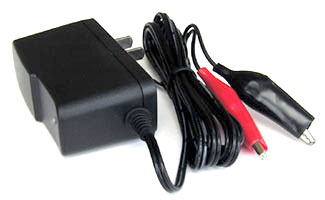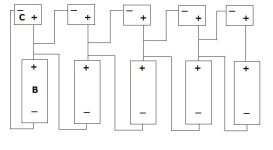First of all, the chargers you used from Batteryspace are not the same as these, from VoltPhreaks, which are specifically for LiFe-type cells. Yours, I believe, have a cutoff of 4.2V and are rated for 1.5A.
These are rated for 2A and have a CC/CV cutoff of about 3.7V. Also, they
do, in fact, have the proper constant current (CC) and then constant voltage (CV) charging profile that is required to best charge the cells. The cutoff voltage for LiFePO4-based cells is lower than what is required for Li-Co and Li-Mn chemistries, which need 4.2V.
Also, the LEDs/lights on these LiFe chargers are actually 3-colored. When a discharged pack is first connected, the charger goes into the CC mode, and the LED is red. When the voltage rises to the cutoff voltage, the charger switches to the CV mode, and the LED turns yellow. When the current drops to about 200 mA, the charger stops, and the LED turns green. Yesterday, after a quick test ride which used 1.440 Ah, it took less than an hour for all 10 LEDs to turn green, which is about right.
In your case, I think the failures you saw were probably related to you trying to cram them into the neck of your custom scooter frame. As you have pointed out, x
yster has used 20 of the same units you apparently fried, for over a year, and they work fine for him.
BTW, one thing you should be aware of is that the power tool companies, like DeWalt and Milwaukee overstate the voltage for their tool packs, for marketing purposes. Most Li-Co cells have charge voltages of 4.2V and "nominal" voltages of around 3.7V per cell. After being connected to a load, even a light one, for about 10 seconds, the cell voltage will drop to a "resting" voltage around 3.7V. Many "older" Li-Ion cells have charge voltages of 4.1V and rated nominal voltages of 3.6V. When the eMolis first came out, we found that in our RC applications, the nominal voltage was about 3.5-3.6V. So if you use 3.6V nominal, your 14s6p setup's "rated"voltage is really more like 50-51V, not the 56V that Milwaukee would have you beilieve. For you to get to 60V, you would really to use 16 or 17 in series, not 15. DeWalt does the same thing. The max charge rate for a123 cells is about 3.7V, but the nominal voltage is more like 3.3V per cell. DeWalt, however, rates their 10-cell tool packs as 36V.
As for the "practicality" of using these 2A chargers with big setups, most days I could care less if it takes two hours or 10, to complete the charging process. If I am in a hurry, however, I have several other SLA and RC chargers, with much higher max charging rates. I have a Zivan NG1 SLA charger, for instance, that will go to 18A and several RC chargers that have a max of 10A. These can be used to get the packs to about the 80-85% level fairly quick, and then I can use the individual cell chargers for the final "topping off" and balancing.
-- Gary






